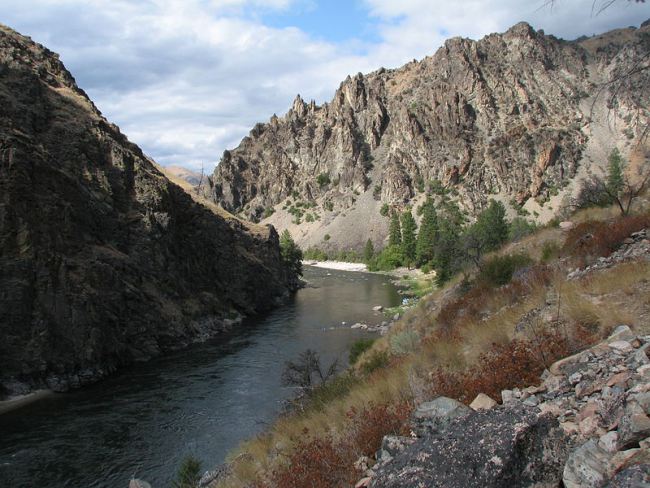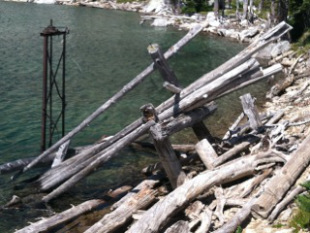What’s All the Buzz in the Boundary Waters?
by Dana Johnson
The Boundary Waters Canoe Area Wilderness (BWCAW) is located within the Superior National Forest in Minnesota and stretches over 115 miles along the Minnesota-Ontario border. The Wilderness, along with Canada’s adjoining Quetico Provincial Park, protects a complex ecosystem of nearly 3,000 glacial lakes connected by a vast, meandering network of streams and portages. This watery landscape is home to a diverse mix of wildlife, and it holds one of the largest remnants of uncut forest east of the Rockies. Humans have relied upon its natural abundance for centuries, including the Ojibwe who navigated its waterways in birch bark canoes. More recently, the area offers an increasingly rare connection to a world that existed before an expanding population, with all of its fast-paced and heavily consumptive interests, took hold.
Efforts to protect this area from the fallouts of Westward Expansion, industrialization, and motorization span back over a century culminating in the designation of the BWCAW. Sigurd Olson, one of the eloquent leaders in the push to protect the Boundary Waters, recognized a tie between the silence of the canoe and something we were losing through the story of progress—the knowledge of what it is to be of and with the land and waters.
"The movement of a canoe is like a reed in the wind. Silence is part of it, and the sounds of lapping water, bird songs, and wind in the trees. It is part of the medium through which it floats, the sky, the water, the shores.... There is magic in the feel of a paddle and the movement of a canoe, a magic compounded of distance, adventure, solitude, and peace. The way of a canoe is the way of the wilderness, and of a freedom almost forgotten. It is an antidote to insecurity, the open door to waterways of ages past and a way of life with profound and abiding satisfactions." -Sigurd Olson, The Singing Wilderness, 1956
Sigurd would be troubled to learn that roughly one-fifth of the Wilderness’s waterways are still subjected to the persistent back and forth buzzing of motorboats including, on some routes, commercial towboats carting paying clients and their canoes to campsites and remote drop-off locations within the Wilderness, turning many entry-points and travel routes into busy motorways. The popular entry point of Moose Lake, where commercial towboat use is particularly excessive, is known for its motorized bottlenecks and the whine of engines. During one trip to survey the Moose Lake entry-point, Wilderness Watch staff were told by an outfitter that Wilderness visitors who would not otherwise consider a motorized tow regularly take a tow because paddling through motorized use areas is so unpleasant. The motorized mess in the Boundary Waters is a good example of why when Wilderness areas are designated it is so important to make sure it’s via a clean wilderness bill, without special provisions.
The Wilderness Act was passed as a counterweight to “an increasing population, accompanied by expanding settlement and growing mechanization,” and to safeguard a few wild areas “in contrast with those areas where man and his own works dominate the landscape.”[1] It expressly prohibits motorized and mechanized uses within Wilderness recognizing that these things represented the opposite of the restraint and humility needed to guard against our compulsion to stand as masters and controllers of the world around us.
It was in this context that the Boundary Waters Canoe Area Wilderness was designated as one of the original Wildernesses in the 1964 Wilderness Act. Unfortunately, due to the familiar story of political pressure, the Wilderness Act included a confusing special provision allowing motorized use already existing in the BWCAW, as long as such use would not undermine the “primitive character of the area.”[2] Motorized use always undermines the primitive character of a wilderness area—that’s why the Wilderness Act prohibits it! This provision was short-lived. In response to “the confusion and litigation generated by the proviso, as well as in reaction to threatened deterioration of the wilderness from excessive use,”[3] Congress repealed the special provision and enacted the BWCAW Act of 1978.[4]
Unfortunately, once again due to political pressure, Congress was not able to eliminate motorboat use outright. Instead, this time around, Congress prohibited all motorboat use within the Wilderness except on a few specifically named lakes, instituted phase-outs of motorized use on other lakes, and imposed motor size restrictions.[5] On lakes where motorboat use was allowed, Congress set a statutory cap at “the average actual annual motorboat use of the calendar years 1976, 1977, and 1978 for each lake,”[6] and the Forest Service calculated and allocated that cap through a series of entry point quotas for each lake. What followed was decades of confused and inconsistent statutory application, an indecipherable hodgepodge of management policies and practices, multiple rounds of litigation, and an increase in particular types of motorized use to the detriment of the Wilderness. Commercial towboat use is a prime example.
Congress did not expressly contemplate the continued use of commercial towboats when it passed the BWCAW Act in ’78, and the Forest Service has never been clear on how it monitors commercial towboat use in relation to the overall statutory cap on motorboat use. That notwithstanding, towboat use continued, and the Forest Service adopted measures to regulate it in the 1993 BWCAW Management Plan. The Plan required towboat operators to obtain special use permits, and it limited towboat use to “1992 levels for numbers of boats, trips, current operators, and specific lakes.” However, Wilderness Watch learned from a series of Freedom of Information Act requests that the Forest Service has not consistently monitored actual commercial towboat use since the inception of the BWCAW Act or since the 1993 Plan, it does not appear to know what the level of towboat trips from 1992 was, it has allowed some commercial towboat operators to run towboat services without a special use permit, and it appears that actual commercial towboat use has been steadily increasing.
Making matters worse, the Wilderness Act prohibits commercial enterprise in Wilderness with the exception of certain “necessary” commercial services.[7] The exception requires a specific finding of necessity—something typically done through a “commercial needs assessment” with requisite public involvement and formal National Environmental Policy Act review. The Forest Service had not done this either, and it wasn’t about to. So, we sued. That lawsuit resulted in a settlement where the Forest Service agreed to prepare a commercial needs assessment to get a handle on the current amount of actual towboat use in the Wilderness, make a determination on whether towboat services are necessary at all—particularly given their impact on wilderness character, and if the Forest Service deems them necessary, to what extent. The Forest Service agreed to complete this process by November 2019.
The Forest Service produced a document that attempts to assess the amount of current towboat use, but it doesn’t assess that use in the context of the overall regulatory scheme (the limitations imposed by the Act and the Plan) and explain how current use is within those limits, it does not analyze necessity in the context of impacts to wilderness character and opportunities for motorized recreation outside of Wilderness, and a host of other issues. You can read our concerns about the Forest Service’s Draft Needs Assessment here: https://wildernesswatch.org/images/wild-issues/2019/10-09-2019-WW-Comments-BWCAW-CNA.pdf. Likely in response to the concerns we raised in the Draft Needs Assessment, the Final Needs Assessment included a reference to an “extent necessary worksheet” that might address some of our concerns (and comply with the settlement agreement). However, in a nod to Orwell, when we submitted a Freedom of Information Act request for this worksheet, the Forest Service refused to give it to us saying the information was privileged and exempt from disclosure.
The Forest Service has indicated it will likely, at an undisclosed point in the future, engage in National Environmental Policy Act review of commercial towboat use in the BWCAW. We’ll keep everyone posted about that process and encourage public involvement when the time comes. In the meantime, the towboats keep buzzing under the cloak of regulatory ambiguity and agency confusion, and we’re assessing our options for additional legal challenges. The moral of the story: Clean, simple wilderness bills without special provisions best protect Wilderness, and we must keep demanding them from Congress. In an era where much of the environmental movement has become apologetic in its approach to land protection, it isn’t surprising that wilderness bills littered with compromise are considered the norm. And we know we can’t expect the agencies to do the right thing without constant vigilance and pressure.
The very idea of Wilderness is on the line, and we must keep the courage to hold that line.
[1] 16 U.S.C. § 1131(a), (c).
[2] 16 U.S.C § 1133(d)(5) (1976), repealed by Pub. L. No. 95-495, 92 Stat. 1649, 1650 (1978).
[3] Minnesota v. Block, 660 F.2d 1240, 1246 (8th Cir. 1981).
[4] Pub. L. No. 95-495, 92 Stat. 1649 (1978).
[5] Pub. L. No. 95-495, T92 Stat. 1649 (1978), 92 Stat. at 1650, 4.
[6] Pub. L. No. 95-495, T92 Stat. 1649 (1978), 92 Stat. at 1651, 4(f).
[7] 16 U.S.C. § 1133(d)(5).
------------------
Dana Johnson is the staff attorney for Wilderness Watch, a national wilderness conservation organization headquartered in Missoula, MT, www.wildernessswatch.org.
 In late October, Marilyn and I headed south for a 226 mile 21-day float trip down the Grand Canyon of the Colorado River. There were four of us, in two rafts. For most of the 20,000 or so folks who annually float the Colorado, the scenery and numerous challenging rapids are big attractions. But for Marilyn and me, the big draw was the vast desert wilderness that the river punctuates. Although I hadn’t rowed challenging whitewater in nearly two decades, we all made it through the rapids upright, though I had a few close calls.
In late October, Marilyn and I headed south for a 226 mile 21-day float trip down the Grand Canyon of the Colorado River. There were four of us, in two rafts. For most of the 20,000 or so folks who annually float the Colorado, the scenery and numerous challenging rapids are big attractions. But for Marilyn and me, the big draw was the vast desert wilderness that the river punctuates. Although I hadn’t rowed challenging whitewater in nearly two decades, we all made it through the rapids upright, though I had a few close calls.

 So now I know why people came up with the idea of aerial spraying DDT to kill pesky bugs ... like the thousands of mosquitoes that attacked me over the summer solstice in the Emigrant Wilderness. Relentless beasts!
So now I know why people came up with the idea of aerial spraying DDT to kill pesky bugs ... like the thousands of mosquitoes that attacked me over the summer solstice in the Emigrant Wilderness. Relentless beasts!
 by Kevin Proescholdt
by Kevin Proescholdt




